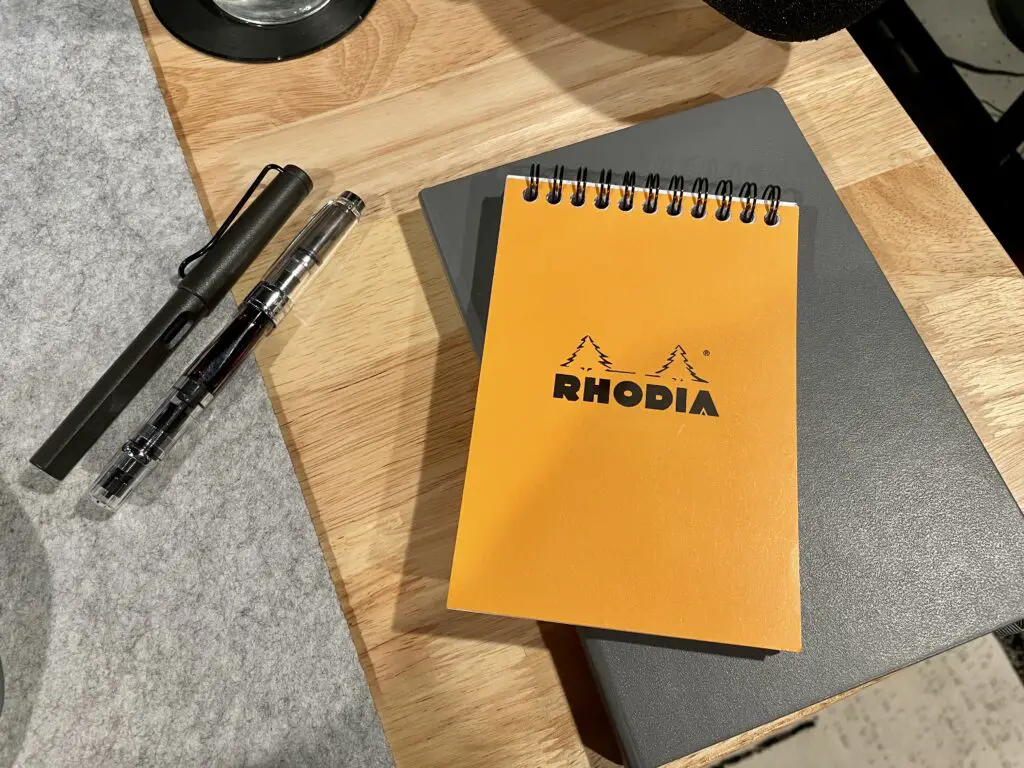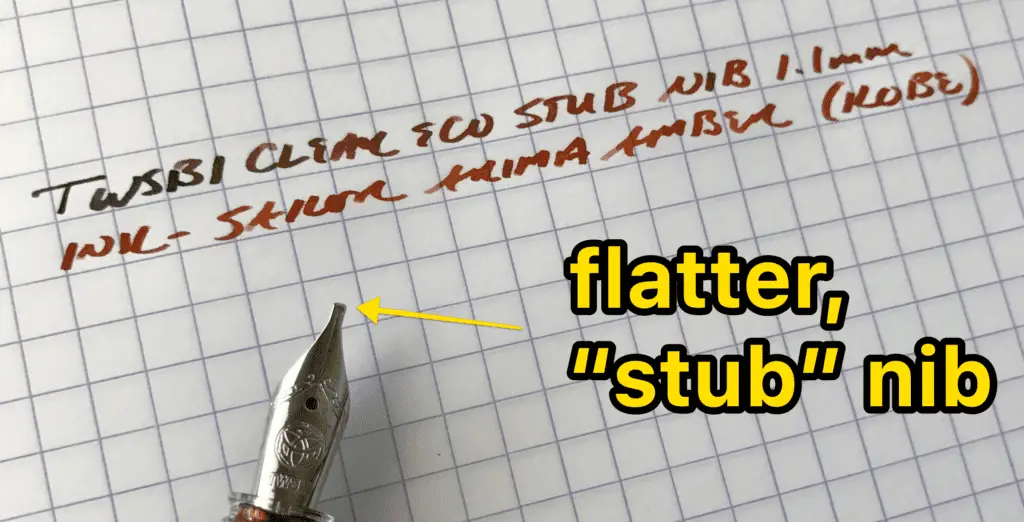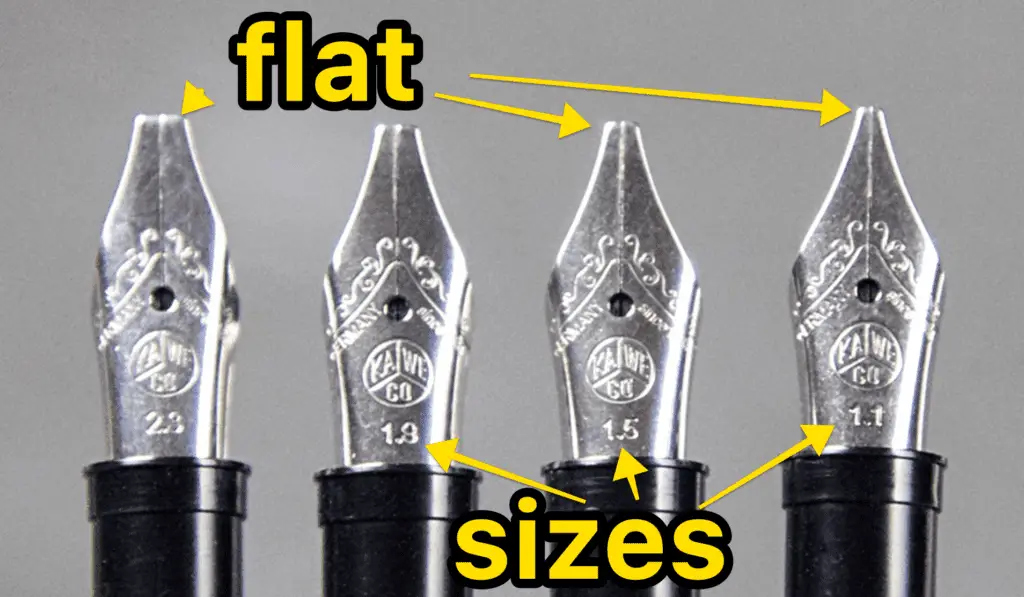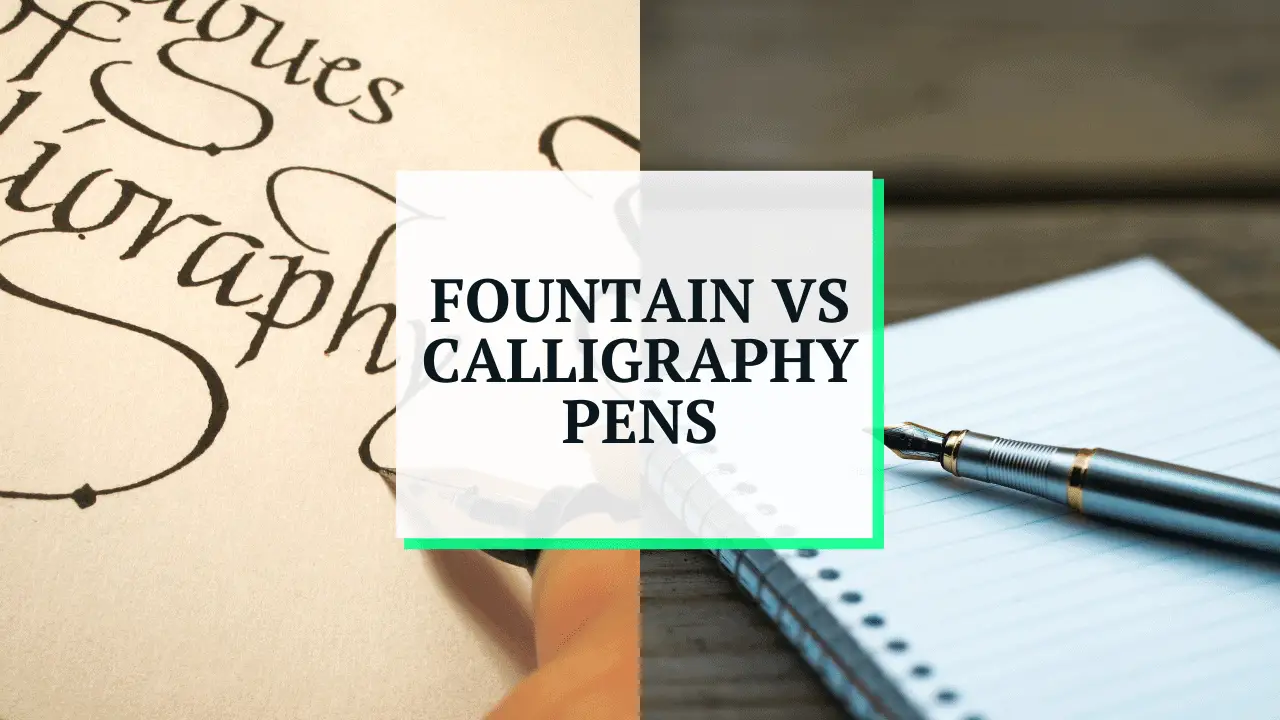Choosing the right pen can make all the difference when it comes to writing. Whether you’re taking notes in class, journaling, or just want to unwind by creating some ART…
But choosing the wrong pen for the job can lead to frustration (and wasted money).
So here’s the lowdown on fountain pens vs calligraphy pens:
While they are similar in some aspects, fountain pens and calligraphy pens are different writing instruments. They use different types of inks, and different nibs, and are generally used for different purposes. While fountain pens can be a classy tool for everyday use and are easy to get started with, calligraphy pens require a bit more practice to use and are generally used for artistic purposes such as calligraphy or lettering.
| Fountain Pen | Calligraphy Pen | |
|---|---|---|
| Purpose | Everyday writing, note taking, drawing | A specific style of hand-lettering, calligraphy |
| Cost | More expensive ($20-50 for beginner fountain pens, up to several hundred dollars for customs!) | Cheaper, $10-30 on average |
| Nibs | A few different writing styles, but generally referred to in terms of nib size (bold, medium, fine, extra fine) | Different shape (for varying degrees of line thickness). Generally just referred to in terms of nib diameter (in mm, i.e. 2.0mm or 3.5mm) |
| Ink | thinner, water-based, huge variety of colors and sheen, shimmer | water + oil based, thicker (for better control while writing) |
What is a fountain pen?
A fountain pen is a writing instrument that uses an ink reservoir to hold the ink. The ink is fed from the reservoir to the nib of the pen, which is then pressed onto paper to create written text.
Fountain pens are refillable, so you can use them over and over again. They come in a variety of sizes and styles (and price points!), so you can choose the one that best suits your needs. Whether you’re looking for a simple pen for everyday use or a luxurious pen for special occasions, there’s a fountain pen out there for you.
What is a calligraphy pen?
On the other hand, a calligraphy pen is a pen that is used for writing in a decorative or artistic manner. These pens have a flat or slanted nib that allows for more varied line width (part of the pen stroke could be thinner, and other parts thicker).
This leads to unique lettering (i.e. calligraphy)!
Fountain Pen vs Calligraphy Pen – Similarities
First, let’s take a look at how fountain pens and calligraphy pens are similar:
1 – Both have a nib that comes in contact with the paper
Both fountain pens and calligraphy pens feature a metal (or gold or rhodium) nib that comes in contact with the paper. This is where the ink is deposited onto the paper to create written text or artwork. The nibs LOOK pretty similar (pointy, shiny, with a small slight through the middle).
However, the nibs ARE slightly different from each other. We’ll take a closer look at that in the next section.
2 – They look very similar
Both types of pens look a lot different than your average ballpoint, gel pen, etc. They’re built to last longer (since they can be refilled usually!), and are in a word, fancier!
Fountain pens and calligraphy pens are similar in that they’re both long, slender writing instruments with a metal nib.
3 – The way they write
If you’re coming from cheaper ballpoint pens, you’ll notice a big difference in the way that fountain pens and calligraphy pens write. The ink generally flows a LOT smoother and easier (especially in fountain pens, see the ink differences below), and are generally held the same way (roughly, and this will depend on your writing style, hand size, etc).
You can generally hold the pens the same way.
Click here to learn the proper way to hold a fountain pen.
4 – Both require high-quality paper
While you can technically use any type of paper with a fountain pen or calligraphy pen, you’ll want to use high-quality paper for the best writing experience. Cheap paper can cause the ink to bleed or feather (spread out) or smudge, and generally just isn’t as nice to write on. We recommend any paper weight over 80gsm (and 100-120gsm is even better).

5 – Fountain pens CAN be used for calligraphy
Believe it or not, most fountain pens actually allow for interchangeable nibs, meaning you can put a “stub nib” on a fountain pen, allowing it to write/draw in a calligraphy style!
There are a ton of different nib sizes and shapes, and this is one reason I love fountain pens so much.
PRO TIP: What is a “stub nib?”

A nib that is ground flat on the end, rather than having round tipping material like standard (extra-fine, fine, medium, broad) nibs. This produces a narrow line on the cross stroke and a broad line on the down stroke, creating a “ribbon” effect.
Fountain Pen vs Calligraphy Pen – Differences
Now that you’ve learned how fountain pens and calligraphy pens are similar, let’s take a look at how they’re different:
1 – The overall purpose is different
Calligraphy is a pretty specific form of writing/art, defined by the varying line widths, letter shapes, etc. Most people wouldn’t use a calligraphy pen for everyday use, normal writing, etc!
And while a fountain pen can be used in a artistic manner (even using a stub nib, etc), they’re generally not going to be used for the same things as a calligraphy pen.
- Journaling
- Notes
- Letters
- Water-color (yes, fountain pens can be used with a water brush to achieve water-color painting!)
2 – The nibs are different
As mentioned before, the overall purpose is different, and it’s the nib shape that gives calligraphy pens their unique look. Calligraphy pens have a nib that is flat on the end, while fountain pens have a more round nib.
Both types of pens offer different nib SIZES, however! They can range from extra-fine (for detailed writing), to broad (for painting/drawing with ink).

Calligraphy nib sizes are generally referred to in terms of “millimeters”, such as 1.1mm, 1.5mm, etc. Also, calligraphy nibs can often “give” a little, i.e. they’re slightly flexible, allowing for more flair and flexibility in lettering.
3 – They use different inks
Fountain pen ink is usually a lot thinner than the ink used in calligraphy pens (the inks are more watery). Calligraphy ink is thicker (more viscosity).
Also, fountain pens almost always have an ink reservoir (which can be filled using a few different filling systems). Some calligraphy pens might have a reservoir, but many are simply a holding section (the handle) connected to the nib, and you can dip the pen in some ink.
PRO TIP: What are “dip pens?”
Just like the name implies, dip pens are pens that you dip in ink! They’re usually made of wood or plastic, and have a metal nib. You can find them in different sizes and shapes, but you’ll usually have to purchase the ink separately. Dip pens are an excellent and efficient way to try out different inks, colors, etc, since you don’t have to refill them constantly!

4 – Price
Both fountain pens and calligraphy pens can be found for between $5 and $30, but the price ceiling on fountain pens is a LOT more.
Collecting fountain pens is much more of a hobby than calligraphy pens, and quality fountain pens will run you $30-100, with some premium models (like the Montblanc pens) costing upwards of $1,000!
Conclusion: Which should you use? Fountain Pen vs Calligraphy Pen
While both pens are similar in appearance, which pen you choose will depend on what you need it for. If you enjoy the look of varying line widths and love the artistic aspect of calligraphy, then go with a calligraphy pen! But if you’re just looking for an everyday pen that you can use for journaling, note taking, and general writing, then go with a fountain pen.
Either way, happy inking 😉
Frequently Asked Questions:
Are fountain pens good for calligraphy?
Yes, some fountain pens can be used for calligraphy, but it really depends on the size and shape of the nib. The standard nibs are rounded and aren’t ideal for the varying line widths of calligraphy. However, you can also purchase flatter, sub nibs that can be used for calligraphy purposes, and swap them out on your fountain pen!
Is calligraphy ink different than fountain pen ink?
Yes, calligraphy ink is different than fountain pen ink. Calligraphy ink is thicker and less watery, while fountain pen ink is thinner. The two inks styles should not be used interchangeably.

